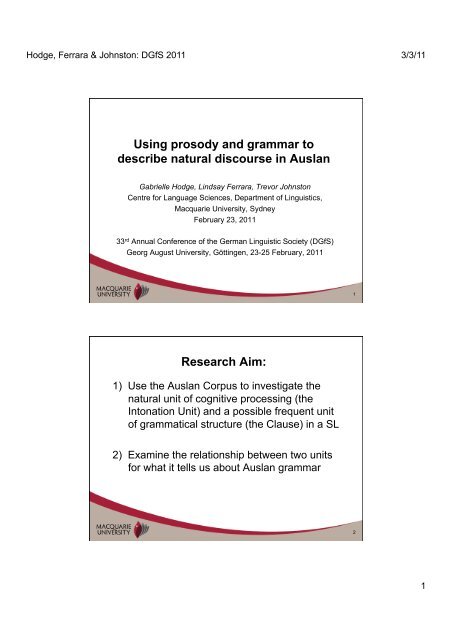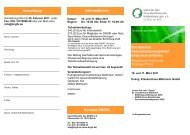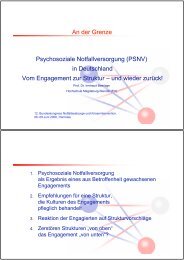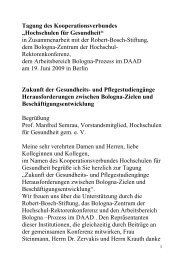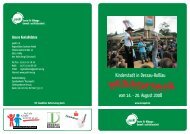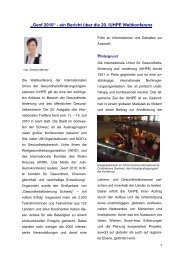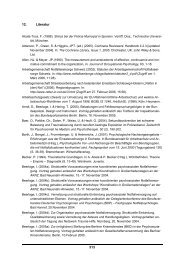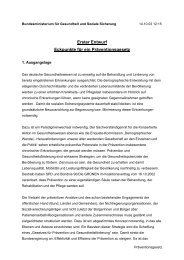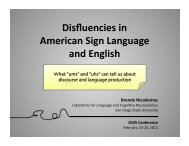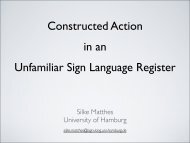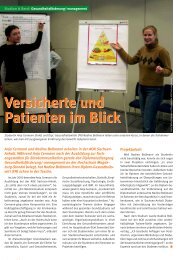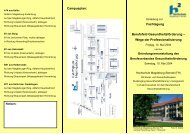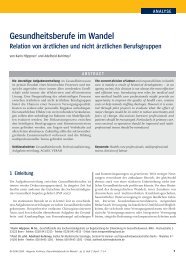Using prosody and grammar to describe natural discourse in Auslan ...
Using prosody and grammar to describe natural discourse in Auslan ...
Using prosody and grammar to describe natural discourse in Auslan ...
Create successful ePaper yourself
Turn your PDF publications into a flip-book with our unique Google optimized e-Paper software.
Hodge, Ferrara & Johns<strong>to</strong>n: DGfS 2011 3/3/11<br />
<strong>Us<strong>in</strong>g</strong> <strong>prosody</strong> <strong>and</strong> <strong>grammar</strong> <strong>to</strong><br />
<strong>describe</strong> <strong>natural</strong> <strong>discourse</strong> <strong>in</strong> <strong>Auslan</strong><br />
Gabrielle Hodge, L<strong>in</strong>dsay Ferrara, Trevor Johns<strong>to</strong>n<br />
Centre for Language Sciences, Department of L<strong>in</strong>guistics,<br />
Macquarie University, Sydney<br />
February 23, 2011<br />
33 rd Annual Conference of the German L<strong>in</strong>guistic Society (DGfS)<br />
Georg August University, Gött<strong>in</strong>gen, 23-25 February, 2011<br />
1<br />
Research Aim:<br />
1) Use the <strong>Auslan</strong> Corpus <strong>to</strong> <strong>in</strong>vestigate the<br />
<strong>natural</strong> unit of cognitive process<strong>in</strong>g (the<br />
In<strong>to</strong>nation Unit) <strong>and</strong> a possible frequent unit<br />
of grammatical structure (the Clause) <strong>in</strong> a SL<br />
2) Exam<strong>in</strong>e the relationship between two units<br />
for what it tells us about <strong>Auslan</strong> <strong>grammar</strong><br />
2<br />
1
Hodge, Ferrara & Johns<strong>to</strong>n: DGfS 2011 3/3/11<br />
We will discuss:<br />
I. Data set—text types <strong>and</strong> participants<br />
II. Aim 1—our current underst<strong>and</strong><strong>in</strong>g of the signed<br />
In<strong>to</strong>nation Unit <strong>and</strong> the signed Clause unit<br />
III. Aim 2—frequent alignment of these units <strong>in</strong><br />
<strong>natural</strong> <strong>Auslan</strong> <strong>discourse</strong><br />
IV. F<strong>in</strong>d<strong>in</strong>gs—major implications of this study<br />
3<br />
I. <strong>Auslan</strong> Data<br />
• Data comes from<br />
the <strong>Auslan</strong> Corpus<br />
<strong>and</strong> PhD research<br />
by one of the<br />
authors<br />
• Three text types<br />
were targeted:<br />
spontaneous <strong>and</strong><br />
stimulated narrative,<br />
<strong>and</strong> conversation<br />
• Data set consists of<br />
20 m<strong>in</strong>utes of<br />
sign<strong>in</strong>g by 18 deaf<br />
native signers<br />
• Video clips were<br />
annotated <strong>in</strong> ELAN<br />
us<strong>in</strong>g a modified<br />
version of the<br />
<strong>Auslan</strong> Corpus<br />
template<br />
4<br />
2
Hodge, Ferrara & Johns<strong>to</strong>n: DGfS 2011 3/3/11<br />
II. Aim 1—How did we <strong>in</strong>vestigate what<br />
constitutes an IU <strong>and</strong> Clause <strong>in</strong> a<br />
SL?<br />
1) We annotated IUs us<strong>in</strong>g a perceptual approach<br />
(Chafe 1994; Croft 1995; Matsumo<strong>to</strong> 2000; Park 2002)<br />
2) We annotated c<strong>and</strong>idates for Clause units us<strong>in</strong>g a<br />
semantic approach <strong>to</strong> identify elements that function<br />
as predicate(s) <strong>and</strong> argument(s). As we annotated<br />
only possible Clause units, we currently refer <strong>to</strong><br />
them as ‘Clause-Like Units’ (CLU)<br />
(Van Val<strong>in</strong> 2005; Johns<strong>to</strong>n & Schembri 2006)<br />
5<br />
What is a signed/spoken In<strong>to</strong>nation<br />
Unit (IU)?<br />
A perceptual unit of cognitive process<strong>in</strong>g<br />
that <strong>in</strong>dicates shifts <strong>in</strong> active ideas, <strong>and</strong><br />
that is the right size <strong>to</strong> be processed <strong>in</strong><br />
its entirety<br />
(Chafe 1979, 1987, 1988, 1994; Croft 1995, 2007;<br />
Matsumo<strong>to</strong> 2000; Park 2002; Wouk 2008)<br />
6<br />
3
Hodge, Ferrara & Johns<strong>to</strong>n: DGfS 2011 3/3/11<br />
1. Sequence of elements comb<strong>in</strong>ed under<br />
a s<strong>in</strong>gle, coherent <strong>in</strong><strong>to</strong>nation con<strong>to</strong>ur<br />
SpL<br />
Changes <strong>in</strong>:<br />
• Pitch<br />
• Duration<br />
• Intensity<br />
• Paus<strong>in</strong>g<br />
• Voice quality<br />
NO ABSOLUTE VALUES<br />
figure vs. ground<br />
SL<br />
Changes <strong>in</strong>:<br />
• Duration (> 2 sec)<br />
• Eye gaze pattern<br />
• Head/<strong>to</strong>rso momentum<br />
• Tensity of h<strong>and</strong>s<br />
• Sign holds (> .3 sec)<br />
• Paus<strong>in</strong>g (>.3 sec)<br />
• Head tilt + eye closure<br />
• Body ‘re-set’ (return <strong>to</strong><br />
‘neutral’ position)<br />
7<br />
2. Interactional <strong>discourse</strong> moves of<br />
participants<br />
SpL<br />
• Changes of turn<br />
• Interruptions, e.g. but,<br />
yeah, hey<br />
• Back-channel<strong>in</strong>g, e.g.<br />
uhuh, hmm, giv<strong>in</strong>g good<br />
‘face’<br />
SL<br />
• Changes of turn<br />
• Interruptions, attentiongrabb<strong>in</strong>g<br />
gestures, e.g.<br />
hey, umm, well<br />
• Back-channel<strong>in</strong>g, e.g.<br />
nodd<strong>in</strong>g, giv<strong>in</strong>g good<br />
‘face’<br />
8<br />
4
Hodge, Ferrara & Johns<strong>to</strong>n: DGfS 2011 3/3/11<br />
9<br />
What is a signed CLU?<br />
SpL (Van Val<strong>in</strong> 2005)<br />
o A Clause is a languagespecific<br />
grammatical<br />
construction conta<strong>in</strong><strong>in</strong>g a<br />
universal semantic<br />
structure<br />
o Semantically identified:<br />
1) Predicat<strong>in</strong>g elements<br />
2) Argument(s) of predicate<br />
3) Adjunct modifiers of P<br />
<strong>and</strong> A<br />
SL<br />
o A Clause-Like Unit is a<br />
possible languagespecific<br />
grammatical<br />
construction conta<strong>in</strong><strong>in</strong>g a<br />
universal semantic<br />
structure<br />
o Semantically identified:<br />
1) Predicat<strong>in</strong>g elements<br />
2) Argument(s) of predicate<br />
3) Adjunct modifiers of P<br />
<strong>and</strong> A<br />
10<br />
5
Hodge, Ferrara & Johns<strong>to</strong>n: DGfS 2011 3/3/11<br />
CLUs <strong>in</strong> <strong>Auslan</strong><br />
We frequently observed:<br />
1. Partly or fully lexical manual signs may<br />
function as predicate(s) <strong>and</strong> argument(s),<br />
e.g. [PT+DS] constructions<br />
2. Manual gestural elements may function as<br />
predicat<strong>in</strong>g elements, e.g. [PT+G]<br />
constructions<br />
3. Non-manual elements may function as<br />
predicat<strong>in</strong>g elements <strong>and</strong> arguments, e.g.<br />
[CA] constructions<br />
11<br />
Prelim<strong>in</strong>ary Results of Annotation<br />
Tokens of<br />
Substantive Units<br />
Substantive IUs 907<br />
CLUs 923<br />
IU-CLU Alignments 732<br />
NB: Please note that we expect <strong>to</strong> revise all annotations—<br />
F<strong>in</strong>al results will be presented <strong>in</strong> out paper<br />
12<br />
6
Hodge, Ferrara & Johns<strong>to</strong>n: DGfS 2011 3/3/11<br />
III. Aim 2—What are the relationships<br />
between IUs <strong>and</strong> CLUs <strong>in</strong> <strong>Auslan</strong>?<br />
One IU<br />
Multiple IUs<br />
One CLU Type I Type III<br />
Multiple CLUs Type II Type IV<br />
13<br />
Type I: Alignment of one IU <strong>to</strong> one CLU<br />
Represents 70.36% of all alignments<br />
14<br />
7
Hodge, Ferrara & Johns<strong>to</strong>n: DGfS 2011 3/3/11<br />
15<br />
Type II: Alignment of one IU <strong>to</strong> multiple<br />
CLUs<br />
Represents 17.35% of all alignments—<br />
strong preference for one IU<br />
<strong>to</strong> align with two CLUs<br />
16<br />
8
Hodge, Ferrara & Johns<strong>to</strong>n: DGfS 2011 3/3/11<br />
17<br />
Type III: Alignment of multiple IUs <strong>to</strong><br />
one CLU<br />
Represents 9.97% of all alignments—<br />
strong preference for two IUs<br />
<strong>to</strong> align with one CLU<br />
18<br />
9
Hodge, Ferrara & Johns<strong>to</strong>n: DGfS 2011 3/3/11<br />
19<br />
Aim I:<br />
o<br />
IV. What does it all mean?<br />
Signed IUs—IUs <strong>in</strong> <strong>Auslan</strong> are perceived by<br />
prosodic con<strong>to</strong>urs <strong>and</strong> <strong>in</strong>teractional <strong>discourse</strong><br />
moves, <strong>and</strong> not by discrete prosodic markers<br />
<strong>in</strong>terpreted as boundary markers<br />
o<br />
Signed CLUs—the relationship between predicate(s)<br />
<strong>and</strong> their argument(s) can be identified us<strong>in</strong>g a<br />
semantic approach, but we do not yet know the<br />
l<strong>in</strong>guistic status of the forms of these elements<br />
20<br />
10
Hodge, Ferrara & Johns<strong>to</strong>n: DGfS 2011 3/3/11<br />
Aim 2:<br />
IV. What does it all mean?<br />
o IUs most frequently align with CLUs (cf. Type I: 70%)<br />
o Prosody <strong>and</strong> <strong>grammar</strong> are tightly entw<strong>in</strong>ed <strong>in</strong> <strong>Auslan</strong>,<br />
it is necessary <strong>to</strong> look at con<strong>to</strong>urs NOT boundaries<br />
or we will miss layers of cohesiveness (cf. all CLU<br />
Types)<br />
o It’s possible <strong>Auslan</strong> uses <strong>prosody</strong> <strong>to</strong> express<br />
relationships between CLUs (cf. Type II: 17%) or<br />
between CLUs <strong>and</strong> other types of grammatical<br />
constituents (cf. Type III: 10%). These relationships<br />
may be represented by morphosyntactic markers <strong>in</strong><br />
non-signed (older? spoken? written?) languages<br />
21<br />
Thank you!<br />
QUESTIONS?<br />
22<br />
11
Hodge, Ferrara & Johns<strong>to</strong>n: DGfS 2011 3/3/11<br />
Acknowledgements – some corpus<br />
material from<br />
ARC Discovery Project #DP0665254<br />
“Use of space <strong>in</strong> <strong>Auslan</strong>” &<br />
L<strong>in</strong>kage Project #LP0882270<br />
“Medical Signbank”<br />
23<br />
Selected References<br />
Chafe, W. (1979). The flow of thought <strong>and</strong> the flow of language. In T. Givón (Ed.), Discourse <strong>and</strong> Syntax (pp.<br />
159-181). New York: Academic Press.<br />
Chafe, W. (1987). Cognitive constra<strong>in</strong>ts on <strong>in</strong>formation flow. In R. S. Toml<strong>in</strong> (Ed.), Coherence <strong>and</strong> Ground<strong>in</strong>g <strong>in</strong><br />
Discourse (pp. 21-51). Amsterdam: John Benjam<strong>in</strong>s.<br />
Chafe, W. (1988). L<strong>in</strong>k<strong>in</strong>g <strong>in</strong><strong>to</strong>nation units <strong>in</strong> spoken English. In J. Haiman & S. A. Thompson (Eds.), Clause<br />
Comb<strong>in</strong><strong>in</strong>g <strong>in</strong> Grammar <strong>and</strong> Discourse (pp. 1-28). Amsterdam/Philadelphia: John Benjam<strong>in</strong>s.<br />
Chafe, W. (1994). Discourse, Consciousness <strong>and</strong> Time: The flow <strong>and</strong> displacement of conscious experience <strong>in</strong><br />
speak<strong>in</strong>g <strong>and</strong> writ<strong>in</strong>g. Chicago: University of Chicago Press.<br />
Croft, W. (1995). In<strong>to</strong>nation units <strong>and</strong> grammatical structure. L<strong>in</strong>guistics, 33, 839-882.<br />
Croft, W. (2007). In<strong>to</strong>nation units <strong>and</strong> grammatical structure <strong>in</strong> Wardaman <strong>and</strong> <strong>in</strong> cross-l<strong>in</strong>guistic perspective.<br />
Australian Journal of L<strong>in</strong>guistics, 27(1), 1-39.<br />
Haspelmath, M. (2007). Pre-established categories don't exist: consequences for language description <strong>and</strong><br />
typology. L<strong>in</strong>guistic Typology, 11(1), 119-132.<br />
Johns<strong>to</strong>n, T., & Schembri, A. (2006). Identify<strong>in</strong>g clauses <strong>in</strong> signed languages: apply<strong>in</strong>g a functional approach.<br />
Paper presented at the DGfS [Deutsche Gesellschaft für Sprachwissenschaft] workshop How <strong>to</strong> recognise<br />
a sentence when you see one: methodological <strong>and</strong> l<strong>in</strong>guistic issues <strong>in</strong> the creation of sign language<br />
corpora, 23-24 February, Bielefeld, Germany.<br />
Langacker, R. W. (2010). How not <strong>to</strong> disagree: The emergence of structure from usage. In K. Boye & E.<br />
Engberg-Pedersen (Eds.), Language Usage <strong>and</strong> Language Structure. Berl<strong>in</strong>/NY: De Gruyter Mou<strong>to</strong>n.<br />
Matsumo<strong>to</strong>, K. (2000). In<strong>to</strong>nation units, clauses <strong>and</strong> preferred argument structure <strong>in</strong> conversational Japanese.<br />
Language Sciences, 22, 63-86.<br />
Park, J. S. (2002). Cognitive <strong>and</strong> <strong>in</strong>teractional motivations for the <strong>in</strong><strong>to</strong>nation unit. Studies <strong>in</strong> Language, 26(3),<br />
637-680.<br />
Van Val<strong>in</strong>, R. D. (2005). Explor<strong>in</strong>g the Syntax-Semantics Interface. Cambridge: Cambridge University Press.<br />
Wouk, F. (2008). The syntax of <strong>in</strong><strong>to</strong>nation units <strong>in</strong> Sasak. Studies <strong>in</strong> Language, 32(1), 137-162.<br />
24<br />
12


